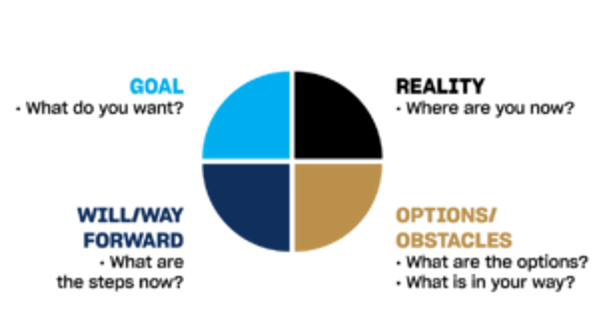Let’s assume you’ve gone through the process of determining whether you should coach, if your employee wants you to coach them, and if they are coachable.
You’ve sharpened your coaching competencies and are ready to give it a go.
It’s now time to explore how to use the powerful GROW model.
GROW stands for Goals, Reality, Opportunity/Obstacles, and Way forward. The key to coaching is to use open-ended questions that start with what, when, where, or how. (Avoid why. It can lead you down a rabbit hole.)
Set up a coaching session (45-minutes to an hour tends to work great to start). Ask your employee to prepare a goal or career aspiration they would like to be coached about. Remember, the coaching process is employee-led and manager-supported.

-
- Goal: Start by agreeing on the goal for the coaching session. If you’ve established and agreed upon an area for development, ask the employee what they most want to focus on during coaching. If you are coaching toward career aspirations, ask what would be most helpful, or what they would like to accomplish during the session.
- Reality: Ask open-ended questions. Let the employee share what they currently are experiencing related to the coaching topic. If you catch yourself talking too much, remember the acronym WAIT (Why Am I Talking), and shift to another open-ended question. It’s common to skip this step and jump to “Way forward.” Avoid doing so, or you might end up coaching off target.
- Options/Obstacles: Next, start exploring options or obstacles. Ask questions like, “What else may be available?” Or, “What stands in the way of you getting there right now?” “What keeps you where you are?” “If you couldn’t do that, what would you do?” This is the brainstorming portion of the coaching session. Once you both feel you’ve come up with enough opportunities and obstacles, it’s time to move into action.
- Way forward: During this final coaching element, the employee determines specific actions to take. Encourage them to engage in small, measurable steps that they can begin (and possibly complete) by your next session.
We recommend scheduling frequent (minimum quarterly) coaching sessions in addition to any regular one-on-ones or performance-feedback conversations. Avoid the temptation to dive into performance challenges or deliverables during coaching sessions.
Remember to follow up with a summary email of your conversation. The purpose of the summary is two-fold: (1) Highlight key takeaways (personal and professional); and (2) clearly state action steps (ways forward). One of our Navigator Program participants, shared this excellent example:
Hello Brian,
Thank you for your time just now for your first coaching session.
I appreciate the clarity of focus you brought to the discussion with your goal of becoming a manager in the future.
It was great to hear about your daily reading of Stoic philosophy and revisiting it each evening as you take stock of the day. Importantly, you called attention to some destructive manager behavior you’ve seen in the past and that you seek to avoid in the future. These are both strong practices that will undoubtedly make you not only suitable to be a manager – but also a good one.
By way of action steps, I will be sending over an invite for a bi-weekly coaching session shortly after this email. You have committed to carving out a 30 minute block on your calendar each week to focus on prioritizing your work.
We’ll check-in on how that prioritization time worked for you during our next coaching sync.
Thanks again, Lincoln


